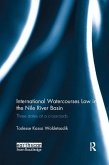- Broschiertes Buch
- Merkliste
- Auf die Merkliste
- Bewerten Bewerten
- Teilen
- Produkt teilen
- Produkterinnerung
- Produkterinnerung
Examining the harmonisation of Intellectual Property policy, law and administration in Africa, this book evaluates the effectiveness of efforts to establish continental Intellectual Property institutions and frameworks.
Andere Kunden interessierten sich auch für
![International Watercourses Law in the Nile River Basin International Watercourses Law in the Nile River Basin]() Tadesse Kassa WoldetsadikInternational Watercourses Law in the Nile River Basin72,99 €
Tadesse Kassa WoldetsadikInternational Watercourses Law in the Nile River Basin72,99 €![New Practitioner's Guide to Intellectual Property New Practitioner's Guide to Intellectual Property]() David R. GerkNew Practitioner's Guide to Intellectual Property79,99 €
David R. GerkNew Practitioner's Guide to Intellectual Property79,99 €![Iima - Business and Intellectual Property Iima - Business and Intellectual Property]() Anurag K. AgarwalIima - Business and Intellectual Property14,99 €
Anurag K. AgarwalIima - Business and Intellectual Property14,99 €![Intellectual Property Securitization: Intellectual Property Securities Volume 1 Intellectual Property Securitization: Intellectual Property Securities Volume 1]() Marc René DeschenauxIntellectual Property Securitization: Intellectual Property Securities Volume 138,99 €
Marc René DeschenauxIntellectual Property Securitization: Intellectual Property Securities Volume 138,99 €![Intellectual Property Intellectual Property]() Michael SpenceIntellectual Property69,99 €
Michael SpenceIntellectual Property69,99 €![Intellectual Property Law and Innovation Intellectual Property Law and Innovation]() William van CaenegemIntellectual Property Law and Innovation153,99 €
William van CaenegemIntellectual Property Law and Innovation153,99 €![Intellectual Commons and the Law Intellectual Commons and the Law]() Antonios BroumasIntellectual Commons and the Law32,99 €
Antonios BroumasIntellectual Commons and the Law32,99 €-
-
-
Examining the harmonisation of Intellectual Property policy, law and administration in Africa, this book evaluates the effectiveness of efforts to establish continental Intellectual Property institutions and frameworks.
Hinweis: Dieser Artikel kann nur an eine deutsche Lieferadresse ausgeliefert werden.
Hinweis: Dieser Artikel kann nur an eine deutsche Lieferadresse ausgeliefert werden.
Produktdetails
- Produktdetails
- Verlag: Taylor & Francis
- 2nd edition
- Seitenzahl: 248
- Erscheinungstermin: 18. Dezember 2024
- Englisch
- Abmessung: 234mm x 156mm x 14mm
- Gewicht: 386g
- ISBN-13: 9781032315386
- ISBN-10: 1032315385
- Artikelnr.: 72082725
- Herstellerkennzeichnung
- Libri GmbH
- Europaallee 1
- 36244 Bad Hersfeld
- gpsr@libri.de
- Verlag: Taylor & Francis
- 2nd edition
- Seitenzahl: 248
- Erscheinungstermin: 18. Dezember 2024
- Englisch
- Abmessung: 234mm x 156mm x 14mm
- Gewicht: 386g
- ISBN-13: 9781032315386
- ISBN-10: 1032315385
- Artikelnr.: 72082725
- Herstellerkennzeichnung
- Libri GmbH
- Europaallee 1
- 36244 Bad Hersfeld
- gpsr@libri.de
Caroline B. Ncube is a Professor in the Department of Commercial Law at the University of Cape Town, South Africa and holds a Research Chair in Intellectual Property, Innovation and Development, under the South African Research Chairs Initiative, which is funded by the Department of Science and Innovation and the National Research Foundation.
1. Intellectual Property and the Public Interest in Africa
1.1 The Intellectual Property Landscape in Africa
1.2 Overview and History of National IP laws
1.3 IP and the public interest
1.3.1 A global public interest?
1.3.2 A continental, sub-regional and national public interest?
1.4 African states' diversity and the need for flexible and nuanced IP
systems
1.4.1 African states' contribution to the articulation and formulation of
the Development Agenda at WIPO
1.4.2 The Dakar Declaration on IP for Africa
1.4.3 TRIPS implementation by African states: a straight-jacket or nuancing
tool?
1.4.4 IP policy focus area: TRIPS Flexibilities
1.4.3.1 Transition periods
1.4.3.2 Definition of invention & other patent grant related flexibilities
1.4.3.3 Parallel imports
1.4.3.4 Compulsory licenses & government use
1.4.3.5 Exceptions
1.4.5 Ongoing work on nuancing African IP systems
1.5 Book overview
Reference List
2. National IP Policy Frameworks in Africa
2.1 Introduction
2.2 Definitions
2.3 The importance of IP policies in Africa
2.4 Factors affecting IP policy design
2.4.1 Public engagement and interest representation
2.4.2 Governmental capacity and co-ordination
2.4.3 Global influences
2.4.4 Technical Assistance
2.4.4.1 Improvement of National, Sub-Regional and Regional IP Institutional
and User Capacity
2.4.4.2 WIPO Framework for Developing National IP Strategies for Innovation
2.4.4.1 The Dakar Declaration on IP for Africa
2.5 State profiles: National IP Policies
2.5.1 States with national IP policies
Botswana
Egypt
The Gambia
Ghana
Madagascar
Malawi
Mozambique
Namibia
Nigeria
Rwanda
South Africa
Uganda
Zambia
Zimbabwe
2.5.2 States with IPDPs
Eswatini
Liberia
Mauritius
Sao Tome and Principe
Senegal
Seychelles
2.5.3 States with national IP policies under formulation
2.5.4 Evaluation of National IP Policies and IPDPs
2.6 Conclusion
Reference List
3. Regional Economic Communities, trade and IP
3.1 Introduction
3.2 Regionalism
3.2.1 Regional co-operation
3.2.2 Regional integration
3.2.3 Market Integration
3.2.4 Development integration
3.2.5 Neo-functional integration
3.3 The AU and the AEC
3.4 The relationship between community laws and national laws
3.5 COMESA
3.5.1 IP Regulatory Framework
3.5.2 IP Policy
3.6 EAC
3.6.1 IP Regulatory Framework
3.6.2 IP Policy
3.7 ECOWAS
3.7.1 IP Regulatory Framework
3.7.2 IP Policy
3.8 SADC
3.8.1 Regulatory Instruments
3.8.2 IP Framework and Guidelines
3.9 TFTA
3.10 Conclusion
Reference List
4: Sub-regional IP organisations
4.1 Introduction
4.2 ARIPO
4.2.1 Organs
Council of Ministers
Administrative Council
Secretariat
Board of Appeal
Committees
4.2.2 Regulatory Instruments
The Harare Protocol
Banjul Protocol on Marks
Arusha Protocol
Kampala Protocol
4.3 OAPI
4.3.1 Organs
Administrative Council
High Commission of Appeal
The Office of the Director General
4.3.2 Regulatory Instruments
(a) Substantive requirements
Annex II: Utility Models
Annex III: Trade marks and service marks
Annex IV: Industrial Designs
Annex X: New Varieties of Plant.
4.5 Conclusion
Reference List
5. Key considerations in the development of a continental IP system
5.1 Introduction
5.2 IP Cooperation
5.2.1 ASEAN
5.2.2 APEC
5.2.3 BRICS
5.3 Harmonisation
5.3.1 Methods of harmonisation
5.3.2 Advantages of harmonisation
5.3.3 Disadvantages of harmonisation
5.3.4 Lessons from existing harmonisation efforts
5.3.4.1 EU
5.3.4.2 MERCUSOR
Unification in OHADA
Conclusion
References
6. Continental IP co-operation: PAIPO
6.1 Introduction
6.2 Historical overview of the AU's efforts to establish PAIPO
6.2.1 Entry into force
6.3 How PAIPO will function
6.3.1 The legal nature of PAIPO
6.3.2 Objectives, principles and functions
6.3.3 Organs of PAIPO
6.3.3.1 The Conference of State Parties
6.3.3.2 The Council of Ministers
6.3.3.3 The Director General and Secretariat
6.3.3.4 The Board of Appeal
6.3.4 Organisational issues (PAIPO, OAPI and ARIPO)
6.3.4.1 Overlapping mandates
6.3.4.2 Relationship between PAIPO, ARIPO & OAPI
6.4 Policy imperatives - the PAIPO statute, development and Human Rights
6.5 Conclusion
7. Intellectual Property in the African Continental Free Trade Area
7.1 Introduction
7.2 Developmental underpinnings of the AfCFTA
7.3 AfCFTA Institutions
7.4 IP in the AfCFTA
7.5 Negotiation and Adoption of the Protocol on IPRs
7.6 Structure, Scope and Content of the Protocol on IPRs
7.6.1 Preamble
7.6.2 Part I: definition, objectives and scope
7.6.3 Part II: principles
7.6.4 Part III: Standards on IPRs
7.6.5 Part IV - VII cooperation on, enforcement, institutional arrangements
and final provisions
7.7 Evaluation and Conclusion
References
8. Harmony or Discord? Lessons for the future African continental IP system
8.1 The status quo
8.2 pursuing the public interest
8.3 Continental Instruments and Institutions
1.1 The Intellectual Property Landscape in Africa
1.2 Overview and History of National IP laws
1.3 IP and the public interest
1.3.1 A global public interest?
1.3.2 A continental, sub-regional and national public interest?
1.4 African states' diversity and the need for flexible and nuanced IP
systems
1.4.1 African states' contribution to the articulation and formulation of
the Development Agenda at WIPO
1.4.2 The Dakar Declaration on IP for Africa
1.4.3 TRIPS implementation by African states: a straight-jacket or nuancing
tool?
1.4.4 IP policy focus area: TRIPS Flexibilities
1.4.3.1 Transition periods
1.4.3.2 Definition of invention & other patent grant related flexibilities
1.4.3.3 Parallel imports
1.4.3.4 Compulsory licenses & government use
1.4.3.5 Exceptions
1.4.5 Ongoing work on nuancing African IP systems
1.5 Book overview
Reference List
2. National IP Policy Frameworks in Africa
2.1 Introduction
2.2 Definitions
2.3 The importance of IP policies in Africa
2.4 Factors affecting IP policy design
2.4.1 Public engagement and interest representation
2.4.2 Governmental capacity and co-ordination
2.4.3 Global influences
2.4.4 Technical Assistance
2.4.4.1 Improvement of National, Sub-Regional and Regional IP Institutional
and User Capacity
2.4.4.2 WIPO Framework for Developing National IP Strategies for Innovation
2.4.4.1 The Dakar Declaration on IP for Africa
2.5 State profiles: National IP Policies
2.5.1 States with national IP policies
Botswana
Egypt
The Gambia
Ghana
Madagascar
Malawi
Mozambique
Namibia
Nigeria
Rwanda
South Africa
Uganda
Zambia
Zimbabwe
2.5.2 States with IPDPs
Eswatini
Liberia
Mauritius
Sao Tome and Principe
Senegal
Seychelles
2.5.3 States with national IP policies under formulation
2.5.4 Evaluation of National IP Policies and IPDPs
2.6 Conclusion
Reference List
3. Regional Economic Communities, trade and IP
3.1 Introduction
3.2 Regionalism
3.2.1 Regional co-operation
3.2.2 Regional integration
3.2.3 Market Integration
3.2.4 Development integration
3.2.5 Neo-functional integration
3.3 The AU and the AEC
3.4 The relationship between community laws and national laws
3.5 COMESA
3.5.1 IP Regulatory Framework
3.5.2 IP Policy
3.6 EAC
3.6.1 IP Regulatory Framework
3.6.2 IP Policy
3.7 ECOWAS
3.7.1 IP Regulatory Framework
3.7.2 IP Policy
3.8 SADC
3.8.1 Regulatory Instruments
3.8.2 IP Framework and Guidelines
3.9 TFTA
3.10 Conclusion
Reference List
4: Sub-regional IP organisations
4.1 Introduction
4.2 ARIPO
4.2.1 Organs
Council of Ministers
Administrative Council
Secretariat
Board of Appeal
Committees
4.2.2 Regulatory Instruments
The Harare Protocol
Banjul Protocol on Marks
Arusha Protocol
Kampala Protocol
4.3 OAPI
4.3.1 Organs
Administrative Council
High Commission of Appeal
The Office of the Director General
4.3.2 Regulatory Instruments
(a) Substantive requirements
Annex II: Utility Models
Annex III: Trade marks and service marks
Annex IV: Industrial Designs
Annex X: New Varieties of Plant.
4.5 Conclusion
Reference List
5. Key considerations in the development of a continental IP system
5.1 Introduction
5.2 IP Cooperation
5.2.1 ASEAN
5.2.2 APEC
5.2.3 BRICS
5.3 Harmonisation
5.3.1 Methods of harmonisation
5.3.2 Advantages of harmonisation
5.3.3 Disadvantages of harmonisation
5.3.4 Lessons from existing harmonisation efforts
5.3.4.1 EU
5.3.4.2 MERCUSOR
Unification in OHADA
Conclusion
References
6. Continental IP co-operation: PAIPO
6.1 Introduction
6.2 Historical overview of the AU's efforts to establish PAIPO
6.2.1 Entry into force
6.3 How PAIPO will function
6.3.1 The legal nature of PAIPO
6.3.2 Objectives, principles and functions
6.3.3 Organs of PAIPO
6.3.3.1 The Conference of State Parties
6.3.3.2 The Council of Ministers
6.3.3.3 The Director General and Secretariat
6.3.3.4 The Board of Appeal
6.3.4 Organisational issues (PAIPO, OAPI and ARIPO)
6.3.4.1 Overlapping mandates
6.3.4.2 Relationship between PAIPO, ARIPO & OAPI
6.4 Policy imperatives - the PAIPO statute, development and Human Rights
6.5 Conclusion
7. Intellectual Property in the African Continental Free Trade Area
7.1 Introduction
7.2 Developmental underpinnings of the AfCFTA
7.3 AfCFTA Institutions
7.4 IP in the AfCFTA
7.5 Negotiation and Adoption of the Protocol on IPRs
7.6 Structure, Scope and Content of the Protocol on IPRs
7.6.1 Preamble
7.6.2 Part I: definition, objectives and scope
7.6.3 Part II: principles
7.6.4 Part III: Standards on IPRs
7.6.5 Part IV - VII cooperation on, enforcement, institutional arrangements
and final provisions
7.7 Evaluation and Conclusion
References
8. Harmony or Discord? Lessons for the future African continental IP system
8.1 The status quo
8.2 pursuing the public interest
8.3 Continental Instruments and Institutions
1. Intellectual Property and the Public Interest in Africa
1.1 The Intellectual Property Landscape in Africa
1.2 Overview and History of National IP laws
1.3 IP and the public interest
1.3.1 A global public interest?
1.3.2 A continental, sub-regional and national public interest?
1.4 African states' diversity and the need for flexible and nuanced IP
systems
1.4.1 African states' contribution to the articulation and formulation of
the Development Agenda at WIPO
1.4.2 The Dakar Declaration on IP for Africa
1.4.3 TRIPS implementation by African states: a straight-jacket or nuancing
tool?
1.4.4 IP policy focus area: TRIPS Flexibilities
1.4.3.1 Transition periods
1.4.3.2 Definition of invention & other patent grant related flexibilities
1.4.3.3 Parallel imports
1.4.3.4 Compulsory licenses & government use
1.4.3.5 Exceptions
1.4.5 Ongoing work on nuancing African IP systems
1.5 Book overview
Reference List
2. National IP Policy Frameworks in Africa
2.1 Introduction
2.2 Definitions
2.3 The importance of IP policies in Africa
2.4 Factors affecting IP policy design
2.4.1 Public engagement and interest representation
2.4.2 Governmental capacity and co-ordination
2.4.3 Global influences
2.4.4 Technical Assistance
2.4.4.1 Improvement of National, Sub-Regional and Regional IP Institutional
and User Capacity
2.4.4.2 WIPO Framework for Developing National IP Strategies for Innovation
2.4.4.1 The Dakar Declaration on IP for Africa
2.5 State profiles: National IP Policies
2.5.1 States with national IP policies
Botswana
Egypt
The Gambia
Ghana
Madagascar
Malawi
Mozambique
Namibia
Nigeria
Rwanda
South Africa
Uganda
Zambia
Zimbabwe
2.5.2 States with IPDPs
Eswatini
Liberia
Mauritius
Sao Tome and Principe
Senegal
Seychelles
2.5.3 States with national IP policies under formulation
2.5.4 Evaluation of National IP Policies and IPDPs
2.6 Conclusion
Reference List
3. Regional Economic Communities, trade and IP
3.1 Introduction
3.2 Regionalism
3.2.1 Regional co-operation
3.2.2 Regional integration
3.2.3 Market Integration
3.2.4 Development integration
3.2.5 Neo-functional integration
3.3 The AU and the AEC
3.4 The relationship between community laws and national laws
3.5 COMESA
3.5.1 IP Regulatory Framework
3.5.2 IP Policy
3.6 EAC
3.6.1 IP Regulatory Framework
3.6.2 IP Policy
3.7 ECOWAS
3.7.1 IP Regulatory Framework
3.7.2 IP Policy
3.8 SADC
3.8.1 Regulatory Instruments
3.8.2 IP Framework and Guidelines
3.9 TFTA
3.10 Conclusion
Reference List
4: Sub-regional IP organisations
4.1 Introduction
4.2 ARIPO
4.2.1 Organs
Council of Ministers
Administrative Council
Secretariat
Board of Appeal
Committees
4.2.2 Regulatory Instruments
The Harare Protocol
Banjul Protocol on Marks
Arusha Protocol
Kampala Protocol
4.3 OAPI
4.3.1 Organs
Administrative Council
High Commission of Appeal
The Office of the Director General
4.3.2 Regulatory Instruments
(a) Substantive requirements
Annex II: Utility Models
Annex III: Trade marks and service marks
Annex IV: Industrial Designs
Annex X: New Varieties of Plant.
4.5 Conclusion
Reference List
5. Key considerations in the development of a continental IP system
5.1 Introduction
5.2 IP Cooperation
5.2.1 ASEAN
5.2.2 APEC
5.2.3 BRICS
5.3 Harmonisation
5.3.1 Methods of harmonisation
5.3.2 Advantages of harmonisation
5.3.3 Disadvantages of harmonisation
5.3.4 Lessons from existing harmonisation efforts
5.3.4.1 EU
5.3.4.2 MERCUSOR
Unification in OHADA
Conclusion
References
6. Continental IP co-operation: PAIPO
6.1 Introduction
6.2 Historical overview of the AU's efforts to establish PAIPO
6.2.1 Entry into force
6.3 How PAIPO will function
6.3.1 The legal nature of PAIPO
6.3.2 Objectives, principles and functions
6.3.3 Organs of PAIPO
6.3.3.1 The Conference of State Parties
6.3.3.2 The Council of Ministers
6.3.3.3 The Director General and Secretariat
6.3.3.4 The Board of Appeal
6.3.4 Organisational issues (PAIPO, OAPI and ARIPO)
6.3.4.1 Overlapping mandates
6.3.4.2 Relationship between PAIPO, ARIPO & OAPI
6.4 Policy imperatives - the PAIPO statute, development and Human Rights
6.5 Conclusion
7. Intellectual Property in the African Continental Free Trade Area
7.1 Introduction
7.2 Developmental underpinnings of the AfCFTA
7.3 AfCFTA Institutions
7.4 IP in the AfCFTA
7.5 Negotiation and Adoption of the Protocol on IPRs
7.6 Structure, Scope and Content of the Protocol on IPRs
7.6.1 Preamble
7.6.2 Part I: definition, objectives and scope
7.6.3 Part II: principles
7.6.4 Part III: Standards on IPRs
7.6.5 Part IV - VII cooperation on, enforcement, institutional arrangements
and final provisions
7.7 Evaluation and Conclusion
References
8. Harmony or Discord? Lessons for the future African continental IP system
8.1 The status quo
8.2 pursuing the public interest
8.3 Continental Instruments and Institutions
1.1 The Intellectual Property Landscape in Africa
1.2 Overview and History of National IP laws
1.3 IP and the public interest
1.3.1 A global public interest?
1.3.2 A continental, sub-regional and national public interest?
1.4 African states' diversity and the need for flexible and nuanced IP
systems
1.4.1 African states' contribution to the articulation and formulation of
the Development Agenda at WIPO
1.4.2 The Dakar Declaration on IP for Africa
1.4.3 TRIPS implementation by African states: a straight-jacket or nuancing
tool?
1.4.4 IP policy focus area: TRIPS Flexibilities
1.4.3.1 Transition periods
1.4.3.2 Definition of invention & other patent grant related flexibilities
1.4.3.3 Parallel imports
1.4.3.4 Compulsory licenses & government use
1.4.3.5 Exceptions
1.4.5 Ongoing work on nuancing African IP systems
1.5 Book overview
Reference List
2. National IP Policy Frameworks in Africa
2.1 Introduction
2.2 Definitions
2.3 The importance of IP policies in Africa
2.4 Factors affecting IP policy design
2.4.1 Public engagement and interest representation
2.4.2 Governmental capacity and co-ordination
2.4.3 Global influences
2.4.4 Technical Assistance
2.4.4.1 Improvement of National, Sub-Regional and Regional IP Institutional
and User Capacity
2.4.4.2 WIPO Framework for Developing National IP Strategies for Innovation
2.4.4.1 The Dakar Declaration on IP for Africa
2.5 State profiles: National IP Policies
2.5.1 States with national IP policies
Botswana
Egypt
The Gambia
Ghana
Madagascar
Malawi
Mozambique
Namibia
Nigeria
Rwanda
South Africa
Uganda
Zambia
Zimbabwe
2.5.2 States with IPDPs
Eswatini
Liberia
Mauritius
Sao Tome and Principe
Senegal
Seychelles
2.5.3 States with national IP policies under formulation
2.5.4 Evaluation of National IP Policies and IPDPs
2.6 Conclusion
Reference List
3. Regional Economic Communities, trade and IP
3.1 Introduction
3.2 Regionalism
3.2.1 Regional co-operation
3.2.2 Regional integration
3.2.3 Market Integration
3.2.4 Development integration
3.2.5 Neo-functional integration
3.3 The AU and the AEC
3.4 The relationship between community laws and national laws
3.5 COMESA
3.5.1 IP Regulatory Framework
3.5.2 IP Policy
3.6 EAC
3.6.1 IP Regulatory Framework
3.6.2 IP Policy
3.7 ECOWAS
3.7.1 IP Regulatory Framework
3.7.2 IP Policy
3.8 SADC
3.8.1 Regulatory Instruments
3.8.2 IP Framework and Guidelines
3.9 TFTA
3.10 Conclusion
Reference List
4: Sub-regional IP organisations
4.1 Introduction
4.2 ARIPO
4.2.1 Organs
Council of Ministers
Administrative Council
Secretariat
Board of Appeal
Committees
4.2.2 Regulatory Instruments
The Harare Protocol
Banjul Protocol on Marks
Arusha Protocol
Kampala Protocol
4.3 OAPI
4.3.1 Organs
Administrative Council
High Commission of Appeal
The Office of the Director General
4.3.2 Regulatory Instruments
(a) Substantive requirements
Annex II: Utility Models
Annex III: Trade marks and service marks
Annex IV: Industrial Designs
Annex X: New Varieties of Plant.
4.5 Conclusion
Reference List
5. Key considerations in the development of a continental IP system
5.1 Introduction
5.2 IP Cooperation
5.2.1 ASEAN
5.2.2 APEC
5.2.3 BRICS
5.3 Harmonisation
5.3.1 Methods of harmonisation
5.3.2 Advantages of harmonisation
5.3.3 Disadvantages of harmonisation
5.3.4 Lessons from existing harmonisation efforts
5.3.4.1 EU
5.3.4.2 MERCUSOR
Unification in OHADA
Conclusion
References
6. Continental IP co-operation: PAIPO
6.1 Introduction
6.2 Historical overview of the AU's efforts to establish PAIPO
6.2.1 Entry into force
6.3 How PAIPO will function
6.3.1 The legal nature of PAIPO
6.3.2 Objectives, principles and functions
6.3.3 Organs of PAIPO
6.3.3.1 The Conference of State Parties
6.3.3.2 The Council of Ministers
6.3.3.3 The Director General and Secretariat
6.3.3.4 The Board of Appeal
6.3.4 Organisational issues (PAIPO, OAPI and ARIPO)
6.3.4.1 Overlapping mandates
6.3.4.2 Relationship between PAIPO, ARIPO & OAPI
6.4 Policy imperatives - the PAIPO statute, development and Human Rights
6.5 Conclusion
7. Intellectual Property in the African Continental Free Trade Area
7.1 Introduction
7.2 Developmental underpinnings of the AfCFTA
7.3 AfCFTA Institutions
7.4 IP in the AfCFTA
7.5 Negotiation and Adoption of the Protocol on IPRs
7.6 Structure, Scope and Content of the Protocol on IPRs
7.6.1 Preamble
7.6.2 Part I: definition, objectives and scope
7.6.3 Part II: principles
7.6.4 Part III: Standards on IPRs
7.6.5 Part IV - VII cooperation on, enforcement, institutional arrangements
and final provisions
7.7 Evaluation and Conclusion
References
8. Harmony or Discord? Lessons for the future African continental IP system
8.1 The status quo
8.2 pursuing the public interest
8.3 Continental Instruments and Institutions








